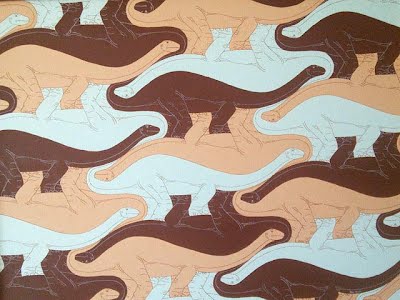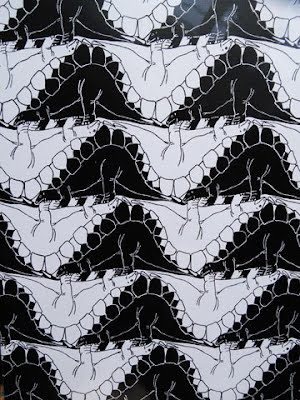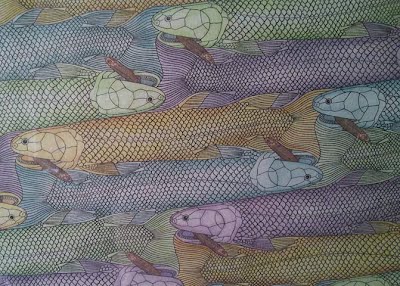Alec Dixon’s Escher-like tessellations, in which he specifically focuses on a variety of dinosaurs and other extinct creatures, can be described as very good indeed, with a convincing silhouette (the main attribute of a high-quality tessellation). Curiously, unlike most other artists, with a typically much broader range, he overwhelmingly restricts his tessellations to dinosaurs to the near exclusion of all other motifs, as part of his special interest in them. (Bruce Bilney of Australia is of another like type, who restricts his interest to indigenous Australian animals.) As a consequence, assessing his work, at least in terms of rating is not a straightforward task, as with the other artists here who include a much broader range of motifs. For instance, in variety, he would be marked down, as there is next to no other motifs. However, this could be argued as unfair, as other artists, with a broader range, are typically lacking in inherent quality of Dixon’s more focussed work. If you are looking for his website this will be in vain, as he hasn't (as yet) got one! His work only came to my attention upon him writing to me in 2019, and to a great extent has been kept under wraps, shown only in locally in the UK, exhibiting in Artists in Essex exhibitions, the Minories Gallery, Colchester and more recently at the Naze Tower, Walton on the Naze, Essex. Dixon has a lifelong interest in art, Escher, zoology (with a degree in the subject) and in particular with dinosaurs. His first works date from 1987, and sporadically since, and of 2019 is trying to be more proactive in publicising his excellent work. Plans are in place for a website.
I now more formally examine his tessellations as according to a set of ten criteria. As alluded to above, these are of a degree of magnitude above other people in the field. On eight of the ten determining aspects of ability and understanding of the issues he scores heavily, with criteria as listed in the introduction: (1) ✓ Recognisable in silhouette (2) ✓ Showing the whole motif (excluding easier to achieve ‘heads’, except for special occasions, of a recognisable figure) (3) ✓ True Tessellations: Excludes inferior ‘breathing room’ or overlap (4) x The number of tessellations in the body of his work (5) x Variety of motifs (6) ✓ A tendency to the more difficult to achieve motifs (7) ✓ Best in Class (8) ✓ Contrasting colouring of tessellations (9) ✓ Finished rendering (10) ✓ Borderline It can be done; there is (tessellation) life after Escher…! In more detail: (1) Recognisable in Silhouette Just about all of Dixon’s tessellations are immediately recognisable in silhouette, not only as generic dinosaurs but of species, the benchmark for quality. The articulation is quite superb, with so many subtleties and nuances permeating throughout his work. The aspect of recognisably of the motif in silhouette is fundamental to the premise of a quality tessellation (an exception is when the animal is portrayed twisting or of an ‘unusual' pose). Lesser artists struggle with this concept (inexplicably so, given its simple premise), and fail to recognise its importance and unfortunately delude themselves as to equating interior life-like interior detail surface detail with an exterior outline that is articulated. (2) Shows the Complete Motif Dixon’s tessellations, without exceptions, are a ‘complete’ motif (as preferred by the leading lights in the field). As an implied premise, the ‘head’ only type is excluded, as this category is lacking in any challenge of worth, being all too easy. Lesser artists frequently do not understand the difference between the two types and undertake such ‘head’ only examples (on account of their less challenging aspect), and unfortunately, delude themselves as to equating these with the more challenging whole body motif. (3) True Tessellations: No spaces, No Overlaps. Dixon’s tessellations are all instances of the ‘true’ type as defined by mathematicians, i.e. a tiling without spaces or overlaps and so exclude the leeway ‘breathing room’ type. Lesser artists frequently include ‘breathing room’ types, ranging from minor to wide swathes of open space (on account of their less challenging aspect), and or ‘overlaps’ and unfortunately delude themselves as to equating these with the more challenging ‘true’ double contour type. (4) The Number of Tessellations The number of his tessellations is what I mark him down for, as having relatively few, of just 19 (including some incomplete). Ideally, he would show many more. His output, for someone I regard as most impressive is low. For comparison, with his peer artists in quality, Sakuramederu has 1,200 (albeit some of these are ‘padded’ somewhat, with variations of the same tessellation), Nicolas has 400, Nakamura has 268, and Escher 137. Lesser artists, which he is not, typically will show a large number of inferior examples, and consider that such large numbers outweigh quality. Unfortunately for them, this is not so! (5) Variety of Motifs The variety of his tessellations is what I mark him down for, focussing solely on dinosaurs to the near exclusion of other animals. He also has a leatherback turtle and a few humans, but no others, although he is indeed capable of doing more. His peer group artists, and indeed other, lesser artists, show more variety. Lesser artists, which he is not, frequently shy away from undertaking such variety, showing simpler to achieve birds and fish to the exclusion of variety, and unfortunately delude themselves as to equating these with the more praiseworthy variety of motifs. (6) Challenging Motifs – Human Figures, Insects This is difficult to assess! Are (his focused) dinosaurs as a motif to be regarded as challenging? Yes and no. For certain, they are more difficult to achieve than birds and fish, although perhaps not quite as difficult as human figures (although Sakuramederu has numerous instances in effect disproves this) and insects. (Although as a category insects lack the obvious appeal of human figures, and so are thus generally neglected.) Lesser artists frequently shy away from such examples (on account of their challenging aspect), or when shown are best described as mutants, with disjoint, out of proportion elements, such over long arms or legs, or anatomical inconsistencies, preferring the simpler to achieve birds and fish. (7) Best in Class Undoubtedly, ‘Best in Class’ is Dixon’s strong point, with his focus on dinosaurs. Typically artists, when they deem to do so show a generic dinosaur, and in effect settle for that (and there’s nothing ‘wrong’ with that), but Dixon goes beyond this, with specifics, with well-known dinosaurs such as T. rex, Stegosaurus, Brontosaurus, and lesser ones too, such as with a Psittacosaurus. A highly desirable feature is that for this particular category of tessellation, in typical poses, the artist produces the leading examples. As can be seen, he is the leading practitioner, with no less than 11 instances to his name. Lesser artists simply lack the ability to produce such instances. (8) Contrasting Colouring of Tessellations Dixon’s tessellations are ideally coloured in contrasting colours. Lesser artists typically do not colour contrast their tessellations, and/or leave as wireframes, for no good reason (from which one can only conclude is that they do not understand the issues). (9) Finished Rendering Dixon’s hand-drawn watercolour work, in style, as regards finish, is of a consistent manner throughout, favouring a degree of detail level as espoused by Escher, of which I consider as the ideal. As a rule, generally, a simplistic finish is to be preferred (as here), as against a photorealistic rendering, as too much detail hinders a clear interpretation of the motif. Lesser artists, albeit with good intention, sometimes render the motifs in too much detail, as in a photograph, believing this to be superior to a more simplistic rendering. However, such instances make for a most trying viewing, with the viewer struggling to identify the individual motifs. Sometimes less is indeed more, as here. (10) Borderline Dixon generally adds a decided borderline, but does, on occasions, in effect has none (save for a pencil line). where colours are used that don’t strictly require a borderline. However, the omission of a borderline cannot be said to be a fault as such, in that the inclusion or exclusion is down to personal choice, depending on the circumstances of the tessellation. Undoubtedly, this is secondary to the tessellation itself, and so of less importance to other, more fundamental issues, as detailed above. Lesser artists invariably omit this feature, not understanding the reasons for its general desirability, namely that of aid in discerning the motifs. General Comments: Positives Dixon’s work is of excellent quality that is deserving of the utmost praise, albeit qualified by the relatively few instances. But that said quality (and not sheer numbers) is everything. A single high- quality instance is worth a thousand or more low quality. Of course, the ideal is quality and numbers, of which it can be done; for instance, see Yasukiyo Yoshida (Sakuramederu), Makoto Nakamura and Alain Nicolas’ work. The all-important aspect of being recognisable instantly in silhouette extends to his entire work. Indeed, none fail this test. Not only are these recognisable in silhouette, but their articulation is invariably very good indeed. In particular, his Brontosaurus is very good. Contrast this with the (few) other people’s dinosaurs figures which lack this finery, and are either clunky or are generally wholly or mostly inferior surface embellishment. Again, such attention to what might at first thought be petty detail simply adds to the inherent quality of the tessellation.
Negatives The only drawbacks are the lack of variety of motif and number, although as he is purposefully focussing on dinosaurs this has to be qualified as to critique, in that he is not trying for variety, although undoubtedly he could do so if he so decided to try. Of the work itself, I am struggling to find anything that can be called negative! Three Highlights Although nearly all are of the same high standard, some are indeed worth singling out in particular for praise, of which I detail below: Brontosaurus Superb! Aside from the motif in general proportion, the articulations here are quite superb; not just of the figure overall, with head, (long) neck, body, legs and tail. Stegosaurus Very nice! Aside from the motif in general proportion, the articulations here are quite superb; not just of the figure overall, with head, body, legs, and plates. Eusthenopteron A little known (to the layman) extinct fish (with a fish in its mouth to make it tessellate!) Here, more detail is shown than typically, with individual scales. Escher Comparison Is Dixon better than Escher? This is not easy to answer, as both artists have different agendas. Indeed, it is impossible to compare as we are not comparing like for like for reasons as detailed above. One can say both yes and no! Yes, in a special instance, in that Escher wholly neglected dinosaurs, and so de facto he trails in Dixon’s wake. No, in that he lacks variety and number. Admittedly, Escher was, to all intents and purposes, the first tessellator (negating Koloman Moser’s examples), and so all the kudos of inventing/discovering a new type of art form is worthy of the utmost praise. Indeed, without Escher, how many people, including Dixon, would have the wit and invention to do this? Probably none. Therefore, Escher stands alone here. However, that said, why should the person who makes the breakthrough in a certain field be regarded as having the field to himself, with other people’s contributions neglected or ignored? As Escher himself stated, he opened the garden gate of tessellation and wandered around. Other people, like Dixon, of a like mind, have now followed him through the gate, and some, but not many, with ideas and innovations of their own to contribute, and indeed, in this case, can be broadly said to emulate Escher. The facts and figures bear this out. Escher did not do everything. Inventory The inventory, in alphabetical order, some complete, some part finished: Archaeopteryx, Allosaurus, Brachiosaurus, Brontosaurus, Cephalaspis, Corythosaurus, Cryptoclidus, Dimetrodon, Elasmosaurus, Eusthenopteron, Ichthyornis, Pachycephalosaurus, Parasaurolophus, Polacanthus, Psittacosaurus, Pteranodon, Pterosaur, Stegosaurus, and T. rex. Summary Dixon is someone who I rate very highly indeed. Indeed, within his specialised choice of motif, he is arguably the leading light in the field. In all instances, Dixon’s dinosaurs are very good indeed, with excellent silhouettes and articulations, and nicely finished art. Of course, the downside to this specific interest is a lack of variety of other motifs, but to a great extent, this can be overlooked, as the quality issue is paramount, of which this is plainly self evident here. In general, dinosaurs as a motif are neglected, with few artists even attempting these. Curiously, Japan has displayed an interest more so than other countries, with three artists of worth. Yasukiyo Yoshida (Sakuramederu) is especially prolific, Makiya Torigoe is less so, but comes nearest to him in quality, whilst Makoto Nakumara also shows some good instances, but of a rather more stylized, non-specific nature. A drawback here in assessing is that to the typical layman, with limited knowledge of dinosaurs, for instance just of well-known instances such as T. rex, Stegosaurus and Brontosaurus (as I was), the merits and nuances of the lesser-known instances are lost, of which a picture reference is essential to better appreciate. But I can assure you that upon comparing, these are indeed truly representative of the name. Well done, Alec! Created 25 October 2019 |


